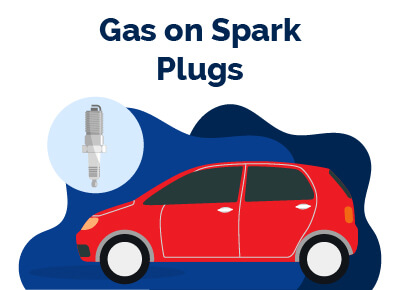Gas on Spark Plugs (Causes, Symptoms, and Fixes)
July 20, 2023


Chris is Head of Content for FindTheBestCarPrice and is based out of Philadelphia, PA. As a seasoned automotive industry analyst and car enthusiast, he ensures the highest level of quality across all our content and curates our picks for the best deals each month.
Chris studied information systems and marketing at Drexel University and writes about a wide range of topics ranging from car buying tips to troubleshooting common mechanical issues.
When he’s not thinking about cars, he likes to stay in with his dog and make an “attempt” to finish a crossword puzzle (he’s not quite at the Saturday/Sunday level…yet). As a former cheesemonger, Chris still has a “sharp” passion for all things cheese, and his fridge is always loaded with it!
Chris also has a passion for things that go fast, and drones are no exception. He spends some of his time writing for Dronesourced.
The absence of spark plugs can render some vehicles immobile, as they are a vital component that directly impacts engine performance.
Defective spark plugs can result in more significant issues, such as persistent cold-starting problems and misfires during acceleration. In some instances, car owners may encounter an unusual issue with plugs, namely the presence of gas on spark plugs.
Additional complications may arise from a malfunctioning ignition system, a slow starter, reduced compression in one or more engine cylinders, or sensors that incorrectly regulate the air-flow mixture. Typically, fuel appears on the spark plug due to an unsuccessful engine start.
When the engine fails to ignite, fuel is introduced into the combustion chamber. The longer the starter is engaged, the more difficult it becomes to start the car, with potentially harmful effects on the engine.
Table of Contents
- How Do Spark Plugs Work?
- Causes of Gas on Spark Plugs
- Symptoms of Gas on Spark Plugs
- How to Start an Engine when the Spark Plugs are Wet with Gas
- How to Know if a Spark Plug is Bad?
- How do Spark Plugs go Bad?
- How Often Should You Change Your Spark Plugs?
- Best Car Deals by Category
- Frequently Asked Questions
How Do Spark Plugs Work?
Consider spark plugs as small bolts of lightning, small in size yet powerful in their ability to ignite an air-fuel mixture buried within your vehicle's engine.
This combustion process generates the energy necessary to move the pistons and propel the car toward its destination.
Additionally, these components have a vital role in dissipating heat from the combustion chamber to the engine's cooling system. Here is a step-by-step explanation:
Step 1: Engaging the ignition system.
When you initiate the ignition process by pressing the "ignition button" or inserting and turning your key, the starter motor is activated, which cranks your engine.
Step 2: Battery power ignites the spark plugs.
Electricity from the battery is transmitted to an induction coil on the engine's combustion system, which converts the battery's 12 volts into up to 45,000 volts, then supplied to the spark plugs.
Step 3: Sparking the air-fuel mixture.
As the voltage of the induction coil increases and is conveyed to the spark plugs, they ignite the air-fuel mixture within the combustion chamber, causing a controlled and small explosion in the gap between the spark plug's electrodes.
Step 4: Combustion provides momentum.
Once the air-fuel mixture is set alight, a chemical reaction occurs, transforming the mixture into an expanded gas or exhaust.
The sudden expansion of this gas within the combustion chamber creates pressure, which propels the vehicle's pistons, transforming chemical energy into kinetic energy required to power the engine.
Step 5: The cycle repeats.
As you continue your journey, the spark plugs continually repeat this process, assisting your car to run smoothly until you arrive.
Causes of Gas on Spark Plugs
Below outlined are the causes of gas on spark plugs.
1. Poor Fuel Quality
Frequently, the prevalent culprit behind the presence of fuel on spark plugs, which can lead to escalated fuel consumption, is a mismatch in the octane number.
If this issue arises when the engine is cold, the fuel's octane rating is probably insufficient.
Additionally, during the warmer season, low-quality fuel tends to ignite more effortlessly than in colder weather conditions.
The intricate orchestration of the fuel flow required for the successful initiation and operation of a cold engine is governed by a network of sophisticated sensors, comprising not only the coolant temperature sensor but also the throttle position sensor, the MAF sensor, and the crankshaft position sensor, among others.
Nevertheless, if the electronic control unit (ECU) is presented with inaccurate information from these sensors, an excessive fuel inflow into the engine cylinders may occur, leading to a saturation of the spark plugs with fuel.
To troubleshoot this issue, it is recommended to examine the sensors, starting with the coolant sensor, which informs the ECU to supply more fuel, followed by the MAF sensor.
Additionally, it is advisable to inspect the ECU memory for any errors, in addition to the fuel correction data.
2. Bad Spark Plugs
The likelihood of encountering this problem is increased if the spark plugs are damaged or worn out, mainly if the spark generated is inadequate to initiate the ignition of the fuel.
3. Faulty Engine Sensors
Malfunctioning sensors can also occasionally result in fuel accumulation on spark plugs. The electronic control unit (ECU) regulates the quantity of fuel supplied, utilizing signals from several sensors.
4. Faulty Ignition System
A feeble spark may arise from deficiencies in the high-voltage wires, such as insulation failure.
Additionally, damage to either one of the ignition system's coils or the entire system itself can contribute to this problem.
5. Low Battery Charge
A car battery in a weakened condition, with substantial current leakage, may prevent proper starter function, resulting in slow rotations.
Consequently, ignition is unlikely to occur, leading to the spark plugs becoming damp. The issue is exacerbated with each futile attempt, as additional fuel is injected, flooding the spark plugs.
In the event of low outside temperatures, inspecting the battery's condition is imperative. If the battery exhibits signs of failure, it is advisable to replace it.
Symptoms of Gas on Spark Plugs
Commencing the engine may present difficulties, which can usually be attributed to a faulty starter, though other components within the engine may be the root cause.
When the engine is cold, its operational stability is frequently compromised, leading to a possible decline in its dynamic performance.
The exhaust fumes are often characterized by their black color and the pervasive odor of fuel.
How to Start an Engine when the Spark Plugs are Wet with Gas
Utilize a wrench to loosen the spark plugs and extract them from the engine block. Once removed, they ought to be desiccated and incinerated.
This can be achieved at home on a gas range. It is advisable always to have an extra set of functioning spark plugs readily available.
Cleanse the cylinders with compressed air. To accomplish this, it is preferable to utilize an air compressor.
However, without such equipment, the gas pedal must be fully depressed while cranking the starter for 10 seconds to dry the cylinders. While doing so, the connectors from the fuel injectors should also be removed.
Remove the spark plugs and reattach the caps before restarting the engine. Repeating the drying process a few times may be necessary, but generally, two or three iterations should suffice.
How to Know if a Spark Plug is Bad?
Spark plugs serve a crucial function in propelling your vehicle, and it's no wonder that indications of defective plugs are noticeable. Some common indications that you might observe are:
1. Clattering, clanging, or detonation-like sounds
When spark plugs start to misfire, there can be unusual sounds emanating from the pressure of the pistons and the combustion not operating correctly.
Since pistons travel at high speeds, an incorrect spark at the wrong time can lead to persistent rattling, clanging, or detonating noises.
2. Difficulty starting the vehicle
If your car is having trouble starting or seems rough and jerky, it's likely due to a spark plug malfunction leading to misfires and unpredictable performance.
3. Reduced performance
Your spark plugs are constantly in use when driving, even when accelerating or shifting gears.
If the spark this tiny device generates isn't performing at optimal levels, your vehicle's performance will suffer, and it won't be able to reach its full potential.
4. Poor gas mileage
There could be various reasons behind low fuel economy, but if your car is equipped with malfunctioning spark plugs, you'll likely be wasting fuel since your vehicle will receive the right spark at the correct time.
We recommend examining your vehicle to avoid further complications if you've identified any of these symptoms. Maintaining healthy spark plugs is critical to your car's ability to start up and maintain power.
How do Spark Plugs go Bad?
The efficacy of spark plugs can decrease due to age, depreciation, or other electrical/ignition system malfunctions.
Over time, combustion, contamination, or overheating can cause them to become "fouled," hindering their capacity to spark the air-fuel mixture and dissipate heat from the combustion chamber.
Furthermore, if the spark plugs are not replaced promptly, the distance between their electrodes increases, necessitating the spark to "jump" a more significant gap to initiate combustion. Ultimately, this gap widening can result in irregular or erratic combustion.
How Often Should You Change Your Spark Plugs?
Fortunately, the need for spark plug replacement is infrequent and can span several years and thousands of miles.
While most car makers recommend replacing spark plugs every 100,000 miles, the duration of their useful life hinges on the type of spark plug, the condition of the engine, and the make, model, and year.
The manufacturer's recommended maintenance schedule may prescribe more or less frequent replacements, depending on the abovementioned factors.
Best Car Deals by Category
Frequently Asked Questions
Can I use wet spark plugs?
No, it would be best if you never used wet spark plugs. Wet spark plugs can cause severe engine damage and compromise your vehicle's performance.
How do I prevent my spark plugs from becoming wet?
To prevent spark plugs from getting wet, maintain your vehicle's engine and fuel system regularly. Replace your air filter, fuel filter, and oil as your vehicle's manufacturer recommends.
Can wet spark plugs cause damage to my vehicle?
Yes, wet spark plugs can cause significant damage to your vehicle. If left unchecked, it can lead to engine misfires, reduced performance, and even engine failure.
It's essential to address the issue promptly to prevent further damage to your vehicle.
Posted in Car Buying Tips, Car Troubleshooting |




